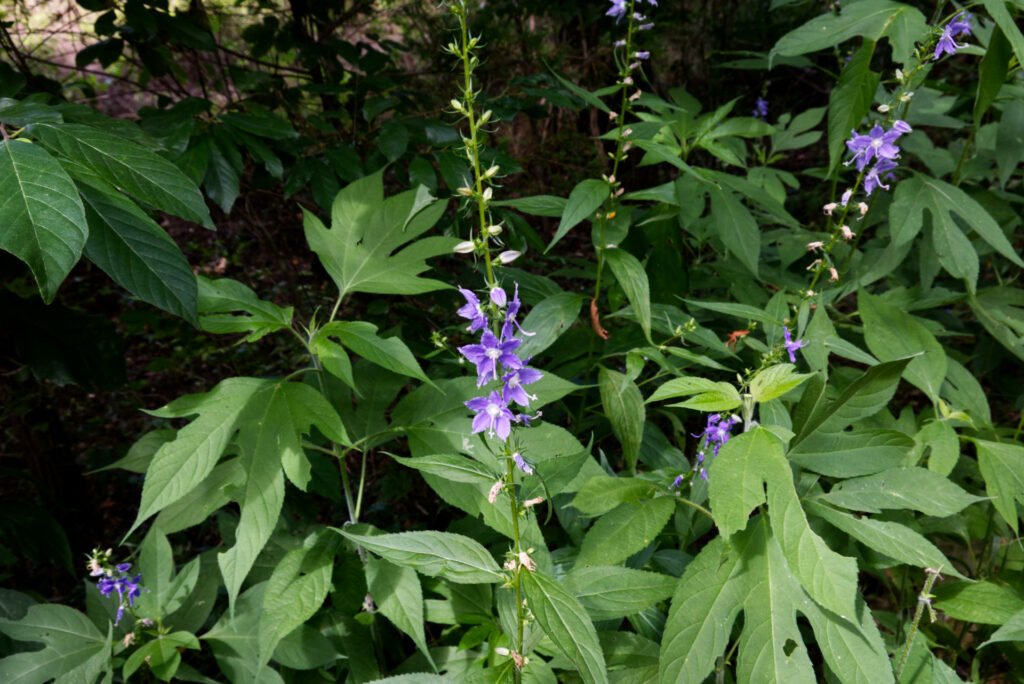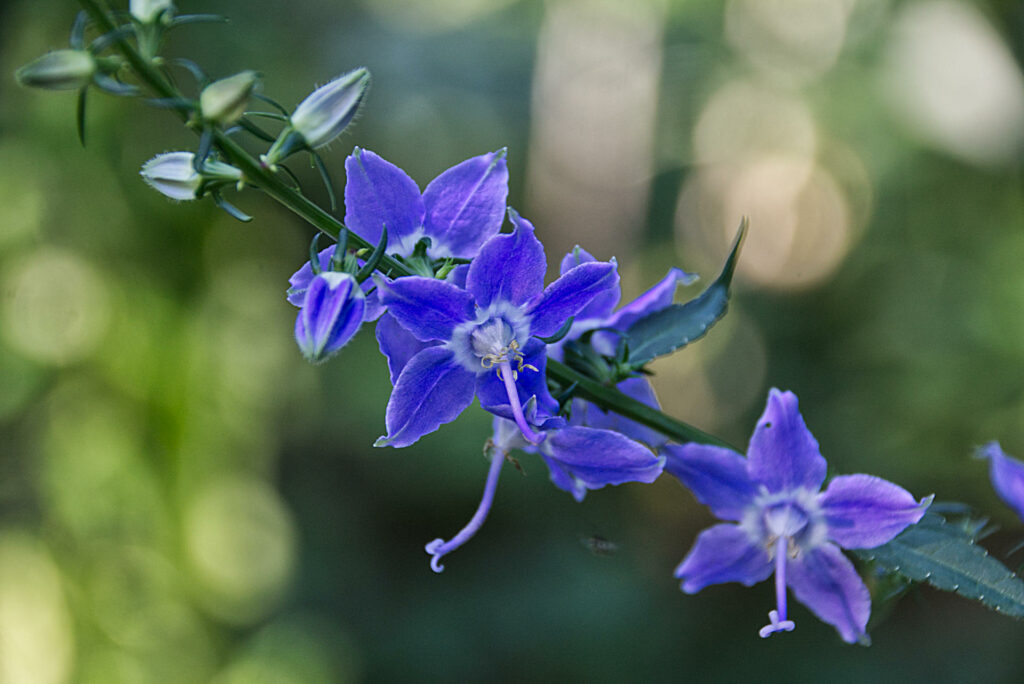
Hello plant lovers! Are you ready to explore the fascinating world of American Bellflower? This unassuming plant may not look like much, but it’s a powerhouse of beauty and benefits. From its delicate, bell-shaped flowers to its medicinal properties, there’s more to this plant than meets the eye. In this article, we’ll dive into the history, uses, and care of American Bellflower, and discover why this plant is a must-have in any garden. So get ready to ring in the bellflower season and learn all about this remarkable plant!
Introduction to American Bellflower
American Bellflower, also known as Campanula americana, is a plant species native to North America. This versatile plant has been used for centuries in both traditional medicine and culinary applications and is a favorite among gardeners for its hardy nature and striking appearance. With its delicate, bell-shaped flowers and unique medicinal properties, American Bellflower is a must-have for any gardener or wild plant enthusiast.
But this unassuming plant is much more than just a pretty face. American Bellflower is known for its potent medicinal properties, which have been used for centuries to treat a wide range of ailments. From respiratory issues to digestive problems, American Bellflower has been known to provide effective relief for many common health issues.
In addition to its medicinal uses, American Bellflower is also a popular ingredient in many culinary recipes. Its leaves and flowers can be used to add flavor and nutrition to a variety of dishes, from salads and soups to teas and tinctures. Whether you’re looking to add some variety to your garden or expand your knowledge of wild plant uses, American Bellflower is a fascinating and valuable plant species that is well worth exploring.
The flowers are an important food source for long-tongue bees such as the bumblebee, as well as smaller bees and wasps. They are also a food source for hummingbirds. The photo below shows a bumblebee and a wasp feeding on the nectar.
So, whether you’re a seasoned gardener or just starting out, I invite you to join me on a journey of discovery as we explore the many uses and benefits of the American Bellflower. From its rich history and diverse applications to its cultivation and care, this remarkable plant is sure to capture your imagination and spark your curiosity. So, let’s dive in and discover the wonders of American Bellflower!
The flowers are an important food source for long-tongue bees such as the bumblebee, as well as smaller bees and wasps. They are also a food source for hummingbirds. The photo below shows a bumblebee and a wasp feeding on the nectar.
Buy American Bellflower seeds here.

How to Identify American Bellflower
American Bellflower is a herbaceous perennial plant that belongs to the family Campanulaceae. It typically grows up to 2-3 feet tall and 1-2 feet wide, with long, slender stems that are often tinged with a purplish hue. The leaves of the American Bellflower are lance-shaped, toothed, and usually measure between 2-4 inches in length. The leaves are dark green and have a slightly hairy texture on both sides.
The flowers of the American Bellflower are its most striking feature and are what give the plant its name. The flowers are bell-shaped and range in color from pale blue to deep violet. They typically measure around 2 inches in length and are arranged in loose clusters at the top of the stems. The flowers bloom in mid to late summer and continue into early fall, providing a beautiful display in any garden.
American Bellflower is a hardy plant that thrives in full sun to partial shade. It prefers well-drained soils that are moist and rich in organic matter but can also tolerate some drought and poor soil conditions. The plant is known for its ability to self-seed and spread easily, making it a popular choice for naturalizing areas of the garden.
Habitat
American Bellflower can be found growing in a variety of habitats across the continent. It is typically found in moist to dry open woods, meadows, prairies, and along roadsides and stream banks.
This plant thrives in areas with full sun to partial shade and prefers well-drained soils that are rich in organic matter. It can tolerate a range of soil types, from sandy to clay, but prefers slightly acidic soils. In the wild, American Bellflower is often found growing alongside other native plants such as goldenrod, asters, and coneflowers.
This hardy plant is well-adapted to surviving in both hot and cold climates and can be found growing in a range of USDA hardiness zones, from Zone 3 to Zone 9. It is also tolerant of drought conditions but will perform best with consistent moisture in its soil.
If you’re looking to add American Bellflower to your garden, it is important to choose a location that mimics its natural habitat. A location with partial shade, well-drained soil, and consistent moisture is ideal. Additionally, this plant is a good choice for naturalizing areas of the garden or for use in rain gardens, as it can help to prevent erosion and attract pollinators.
Buy American Bellflower seeds here.

Medicinal Uses
American Bellflower has a long history of use in traditional medicine, particularly by Native American tribes. The plant contains a variety of compounds with potential health benefits, including flavonoids, tannins, and saponins.
One of the primary medicinal uses of American Bellflower is for respiratory ailments such as coughs, colds, and bronchitis. The plant contains expectorant properties, which can help to loosen and expel phlegm from the lungs. A tea made from the leaves and flowers of the plant is often used for this purpose.
American Bellflower has also been used to promote wound healing and reduce inflammation. The plant contains compounds with antimicrobial and anti-inflammatory properties, which can help to prevent infections and reduce swelling. Poultices made from the leaves and flowers can be applied topically to wounds and bruises.
In addition, American Bellflower has been used to alleviate digestive issues such as diarrhea and stomach cramps. The plant contains astringent properties, which can help to tone the digestive tract and reduce inflammation. A tea made from the roots of the plant is often used for this purpose.
Some studies have also suggested that American Bellflower may have potential anti-cancer properties. The plant contains compounds that have been shown to inhibit the growth of cancer cells in vitro, although more research is needed to confirm these findings.
It is important to note that while the American Bellflower has been used for centuries in traditional medicine, it should not be used as a substitute for medical treatment. As with any medicinal herb, it is important to consult with a healthcare provider before using American Bellflower for medicinal purposes, particularly if you are pregnant, nursing, or taking medications.
Ways to Use American Bellflower Medicinally
There are several ways to use American Bellflower for medicinal purposes, depending on the ailment being treated.
Tea Made From Flowers and Leaves
For respiratory issues such as coughs and bronchitis, a tea made from the leaves and flowers of the plant is often recommended. To make the tea, steep a handful of fresh or dried leaves and flowers in hot water for 10-15 minutes. Strain and drink the tea while it is still warm.
Poultice
For wound healing and inflammation, a poultice made from the leaves and flowers of the plant can be applied topically. To make a poultice, crush fresh leaves and flowers into a paste and apply directly to the affected area. Cover the poultice with a clean cloth and leave on for 15-30 minutes. Repeat as needed.
Root Tea
For digestive issues such as diarrhea and stomach cramps, a tea made from the roots of the plant is often recommended. To make the tea, chop or grate the roots and steep them in hot water for 10-15 minutes. Strain and drink the tea while it is still warm.
Edible Uses
American Bellflower has several edible uses. The leaves, flowers, and roots are all edible, and each part can be used in a variety of ways. The leaves and flowers can be used fresh in salads or as a garnish, and can also be cooked and used in soups, stews, or as a cooked vegetable. The roots can be harvested in the fall and used as a starchy root vegetable. They can be boiled or roasted and used in soups, stews, or mashed like potatoes. The flavor of American Bellflower is mild and slightly sweet, making it a versatile addition to many dishes. However, it is important to note that while American Bellflower is edible, it is not commonly consumed and should only be eaten after proper identification and research.
You can learn more about the American Bellflower in the USDA Plant Database. And if you would like to learn more about wildflowers and other plants native to the Ozarks be sure and check out our list of articles.
FAQs:
Q: What are the uses of American bellflower?
A: American Bellflower has various uses, including medicinal and edible purposes. Its root is used as a traditional medicine to treat respiratory and digestive issues, while the flowers and leaves can be eaten raw in salads or cooked in soups and stews. It is also a popular ornamental plant in gardens.
Q: Is Campanula bellflower poisonous?
A: While Campanula bellflower is not toxic to humans, it may be toxic to pets if ingested in large amounts. It is always best to keep plants away from pets and small children to prevent accidental ingestion.
Q: Are creeping bellflower flowers edible?
A: While some varieties of bellflower are edible, creeping bellflower (Campanula rapunculoides) is not typically consumed due to its bitter taste and potential toxicity.
Q: Are all Campanulas edible?
A: No, not all Campanula varieties are edible. Some species, such as the creeping bellflower, are not recommended for consumption due to their bitter taste and toxicity.
Q: What is Campanula used for in medicine?
A: Campanula is used in traditional medicine to treat respiratory and digestive issues. The root of American Bellflower, for example, is used to make a tea that can help with coughs, bronchitis, and stomach problems.
Q: What is the spiritual meaning of the bellflower?
A: In various cultures, bellflowers have been associated with good luck, gratitude, and humility. In the language of flowers, the bellflower is often seen as a symbol of affection, constancy, and gratitude.
Q: Is campanula the same as bellflower?
A: Yes, Campanula is the scientific name for the bellflower genus, which includes a variety of species.
Q: Is American Bellflower invasive?
A: While American Bellflower can spread quickly in the right conditions, it is not considered invasive in most regions.
Q: Should Bellflower be cut back in the fall?
A: Bellflowers should be cut back in the fall to prevent the plants from becoming too woody and to promote healthy growth in the spring.
Q: What is a companion plant to bellflower?
A: Bellflowers pair well with a variety of other plants, including geraniums, coreopsis, and lavender. They also make great companions to other shade-loving plants like hostas and ferns.